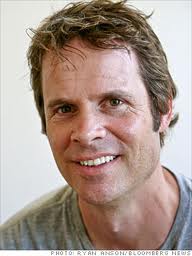 Pandora founder and Chief Strategy Officer Tim Westergren was spotlighted in a hosted Q&A session at the Goldman Sachs “Communacopia” conference yesterday. (Transcript here; elaborate registration required.) In a wide-ranging discussion, Westergren elaborated on Pandora’s business priorities, the state of music rights management globally, the company’s ad sales efforts, competition from Apple, the Nielsen/Arbitron merger, and several other topics.
Pandora founder and Chief Strategy Officer Tim Westergren was spotlighted in a hosted Q&A session at the Goldman Sachs “Communacopia” conference yesterday. (Transcript here; elaborate registration required.) In a wide-ranging discussion, Westergren elaborated on Pandora’s business priorities, the state of music rights management globally, the company’s ad sales efforts, competition from Apple, the Nielsen/Arbitron merger, and several other topics.
“Our goal is to supplant the existing broadcasts of formal radio, becoming much more pleasing to consumers,” Westergren remarked at the start. Throughout the interview he emphasized Pandora’s main differentiator being the quality of its music experience (“We build better playlists”), and a stay-the-course roadmap absent of reinvention.
Pandora is a two-tier Internet radio platform that offers free listening supported by advertising, and ad-free subscription membership. Westergren clearly articulated how the two programs, with their respective costs and revenues, are balanced. Business growth efforts are concentrated on the ad side, with the premium membership portion considered supplementary. Subscriptions account for 20 percent of revenue. “We’re not a premium business […] the real name of the game for us is delivering on the ad-supported business […] that’s really where the home run is.”
subscription membership. Westergren clearly articulated how the two programs, with their respective costs and revenues, are balanced. Business growth efforts are concentrated on the ad side, with the premium membership portion considered supplementary. Subscriptions account for 20 percent of revenue. “We’re not a premium business […] the real name of the game for us is delivering on the ad-supported business […] that’s really where the home run is.”
Accordingly, the free-listening cap applied during this past summer was not a ploy to drive subscriptions, Westergren said, although it did motivate some users to sign up. The cap’s purpose was to solve under-monetization of a portion of non-paying mobile listeners. When that loss was corrected (no specifics there from Westergren), the cap was removed.
When it comes to supplanting broadcast radio, distribution is paramount. The Pandora founder talked about capturing market share in cars and in homes (neatly corresponding to survey results released yesterday by Edison Research showing car and home as AM/FM strongholds), and a strategy of ubiquity. A significant portion of Pandora’s engineering force is dedicated to embedding the service in all kinds of devices, from dashboards to in-car CD players to refrigerators.
If device distribution is proceeding quickly, geographic expansion is stalled. According to Westergren, the problem is music rights negotiations. It’s no secret that Pandora is struggling with content costs. “Rights administration is just not a very healthy part of the music business […] rights are granted country by country, territory by territory.” Pandora was able to open in Australia and New Zealand because of favorable royalty setups, but has been thwarted in other regions because of licensing obstacles. “As we think about deploying in new countries, right now we can’t even begin to do it.”
A few other points:
- Pandora is embedded in over 1,000 devices.
- The service’s recommendation engine, built on the Music Genome Project, is enhanced by over 36-billion up/down votes by users.
- Westergren has been aggressively hiring local sales specialists, region by region according to market share.
- There is no immediate, specific plan for recently-raised capital. Acquisitions are possible, but nothing on the horizon.
- Pandora’s audio ad load will never approach that of broadcast radio. It is possible to achieve a “fantastic business” with fewer commercials.
- Westergren likes the Nielsen/Arbitron merger for the usual “common currency” reasons.
- The competitive impact of iTunes Radio will be “modest.” Pandora has faced many large competitors, and its share has grown.
- Pandora is the third-largest generator of mobile revenue.
